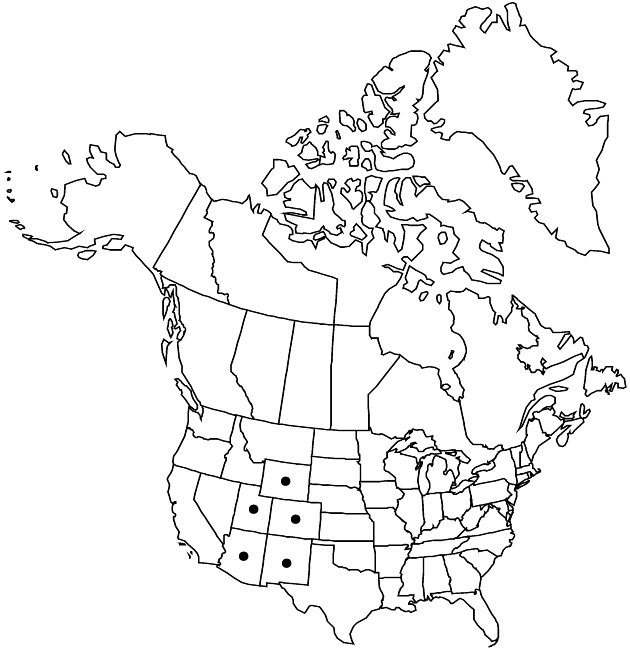Difference between revisions of "Senecio bigelovii"
in War Department [U.S.], Pacif. Railr. Rep. 4(5): 111. 1857.
FNA>Volume Importer |
imported>Volume Importer |
||
| Line 6: | Line 6: | ||
|place=4(5): 111. 1857 | |place=4(5): 111. 1857 | ||
|year=1857 | |year=1857 | ||
| + | }} | ||
| + | |special_status={{Treatment/ID/Special_status | ||
| + | |code=F | ||
| + | |label=Illustrated | ||
| + | }}{{Treatment/ID/Special_status | ||
| + | |code=E | ||
| + | |label=Endemic | ||
}} | }} | ||
|basionyms= | |basionyms= | ||
| Line 23: | Line 30: | ||
-->{{Treatment/Body | -->{{Treatment/Body | ||
| − | |distribution=s Rocky Mountains and adjacent areas of the United States. | + | |distribution=Ariz.;Colo.;N.Mex.;Utah;Wyo.;s Rocky Mountains and adjacent areas of the United States. |
|discussion=<p>Varieties 2 (2 in the flora).</p><!-- | |discussion=<p>Varieties 2 (2 in the flora).</p><!-- | ||
--><p>The two varieties of <i>Senecio bigelovii</i> are distinguished by morphologic tendencies and by geography.</p> | --><p>The two varieties of <i>Senecio bigelovii</i> are distinguished by morphologic tendencies and by geography.</p> | ||
| Line 54: | Line 61: | ||
|basionyms= | |basionyms= | ||
|family=Asteraceae | |family=Asteraceae | ||
| − | |distribution=s Rocky Mountains and adjacent areas of the United States. | + | |distribution=Ariz.;Colo.;N.Mex.;Utah;Wyo.;s Rocky Mountains and adjacent areas of the United States. |
|reference=None | |reference=None | ||
|publication title=in War Department [U.S.], Pacif. Railr. Rep. | |publication title=in War Department [U.S.], Pacif. Railr. Rep. | ||
|publication year=1857 | |publication year=1857 | ||
| − | |special status= | + | |special status=Illustrated;Endemic |
| − | |source xml=https:// | + | |source xml=https://bibilujan@bitbucket.org/aafc-mbb/fna-data-curation.git/src/bb6b7e3a7de7d3b7888a1ad48c7fd8f5c722d8d6/coarse_grained_fna_xml/V19-20-21/V20_1205.xml |
|tribe=Asteraceae tribe Senecioneae | |tribe=Asteraceae tribe Senecioneae | ||
|genus=Senecio | |genus=Senecio | ||
Revision as of 20:44, 27 May 2020
Perennials, (20–)40–80(–120) cm (caudices fibrous-rooted). Herbage usually floccose-tomentose to glabrescent, sometimes glabrous. Stems single or loosely clustered. Leaves progressively reduced distally; petiolate (proximal); blades ovate to lanceolate, 7–15 × (1–)2–5 cm, bases contracted or tapered, margins subentire or serrate to dentate (mid and distal leaves similar, sessile, bractlike, often clasping). Heads nodding (especially when young), (1–)3–12(–20) in racemiform or paniculiform arrays (terminal heads often largest). Calyculi of 4–10 linear bractlets (lengths mostly 1/3–1/2 phyllaries, sometimes 1 or 2 equaling phyllaries). Phyllaries ± 13 or ± 21, 6–12 mm, tips green. Ray florets 0. Cypselae glabrous. 2n = 40.
Distribution

Ariz., Colo., N.Mex., Utah, Wyo., s Rocky Mountains and adjacent areas of the United States.
Discussion
Varieties 2 (2 in the flora).
The two varieties of Senecio bigelovii are distinguished by morphologic tendencies and by geography.
Selected References
None.
Key
| 1 | Herbage glabrous or nearly so (at flowering); blades of proximal leaves often abruptly contracted or at least obtuse at bases; mid and distal leaves clasping; phyllaries mostly 13, 6–8+ mm | Senecio bigelovii var. bigelovii |
| 1 | Herbage often floccose-tomentose, especially among heads and on abaxial faces of leaves; blades of proximal leaves usually tapered to petioles; mid and distal leaves weakly, if at all, clasping; phyllaries mostly 21, (7–)8–12 mm | Senecio bigelovii var. hallii |